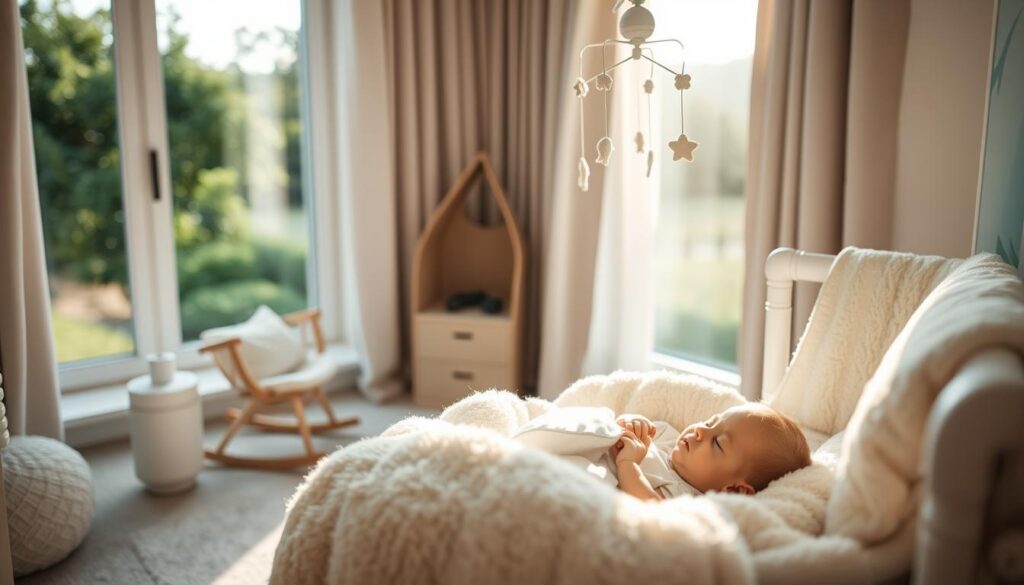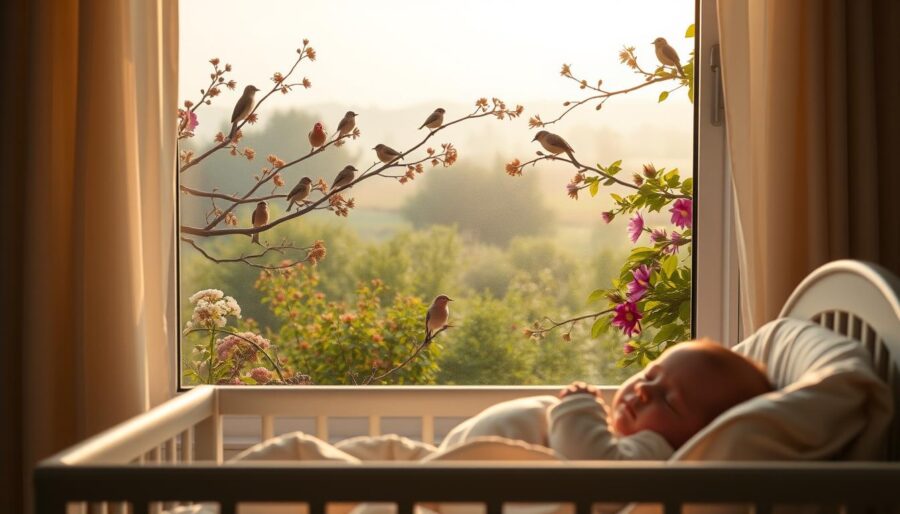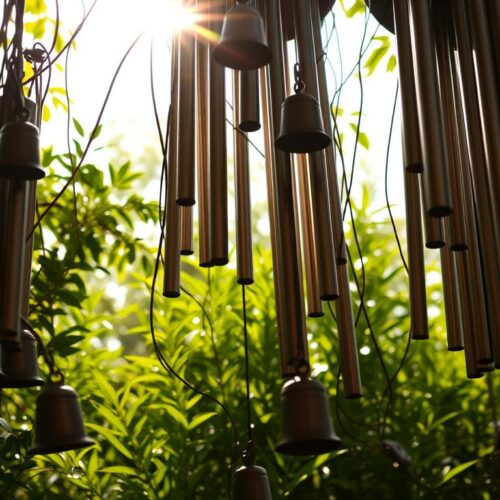As the seasons change in the U.S., you might hear more birds singing. This could affect how your baby sleeps. In spring and early summer, birds often build nests close to homes. This means your baby’s room might get noisier. These natural sounds can be soothing or cause early wake-ups.
Studies of European starlings and canaries show they sing for complex reasons. It’s not just for joy. Songs change with the breeding season and are different from those sung in groups. This can influence your baby’s sleep, especially when windows are open on nice mornings.
The amount of daylight and its timing are also factors. As days get longer or shorter, your baby’s sleep cycle might change. Using blackout curtains and consistent sounds can help manage this. But, it’s hard to say if bird sounds are helpful or not.
Everyone wants peaceful nights and smooth mornings. By understanding bird songs throughout the year, you can prepare better. The aim is to enjoy nature’s sounds without letting them disrupt your life.
In the following parts, you’ll learn about bird communication. You’ll see why their singing varies and how it affects babies’ sleep. With some guidance, you can adjust your home’s ambiance for every season.
Understanding Seasonal Bird Sounds
Bird sounds change with the seasons. In spring, their songs become longer and more complex as they look for mates and protect their space. When fall and winter come, their calls get shorter and help them communicate in groups. The sounds we notice also depend on our daily routines and our kids’ schedules.
As the days get longer, dawn breaks earlier, leading to more bird activity before the sun is up. The dawn chorus is loudest in late spring and early summer, with many birds singing at once. Without blackout curtains or good insulation, this can wake you up earlier than expected.
Birds like to nest near our homes during their nesting season. Robins, house finches, barn swallows, and Carolina wrens might choose spots like porch planters. You’ll hear different bird sounds, from calls to feeding noises and soft begging of chicks. Plus, the adults’ songs can fill your yard.
The sounds birds make have meaning. They can show their feelings, intentions, and how close they are. A long song might mark territory, and short sounds keep birds connected. Knowing these signals helps us understand birdsong around our homes.
Tracking bird sounds for a week reveals patterns linked to weather, light, and your area’s natural features. Adding bird feeders and water features can make birds more active at certain times. This knowledge helps you organize your family’s daily routines without unexpected noise from birds.
The Science Behind Bird Sounds
The songs of birds change with the seasons, but there’s a lot going on beneath that. For many birds, their singing reflects a deep inner need. When it’s time to mate, their songs become more complex. They’re trying to attract a partner or mark their territory. At other times, their songs help them bond with each other and communicate.
In their brains, there’s a special area that makes them feel good when they sing. Studies show that singing for love doesn’t always give them a reward. But singing together with others just for fun does. This shows us why songs change with the situation.
Birds listen carefully too. Young birds learn from listening to older birds. And the adults like songs that show a bird is strong and healthy. This shows there’s a reason behind the sounds they make. Their songs share information and bring them together, especially at certain times of the year.
At your place, this means you might hear more bird songs early in the morning or near their nests during certain seasons. In spring, as they’re getting ready to mate, you’ll hear more sounds mixed in. This creates a lively backdrop compared to the calmer songs heard in other seasons.
Baby’s Sleep Patterns and Environmental Sounds
Getting your baby into a sleep routine? Light during the day and timing are key. Their sleep cycle matures in the first months, with sleep hormones rising at night and energy hormones in the morning. Long summer days can make bedtime later and wake the baby up earlier, especially with outside noises.
Bird sounds change with the season and time. Early morning has more breeding calls, while there’s more chatter later. If birds are by a window, their feeding can wake a baby. Using dim lights and calming the baby before bed can help sync their sleep with quieter times.
To lessen outside sounds, try blackout curtains and continuous white noise. Make the nursery cool and dark for timely hormone release. Adjusting bedtime slightly can ease stress and help with hormone balance as the seasons shift.

| Timing Factor | Typical Sound Pattern | Impact on Baby Sleep | Practical Adjustment |
|---|---|---|---|
| Dawn (Breeding Season) | Pronounced, structured calls near sunrise | May clash with rising cortisol and trigger early waking | Use blackout curtains; start white noise before first light |
| Evening Light | Lower bird activity but lingering outdoor noise | Delayed melatonin onset if room stays bright | Dim lights an hour before bed; close shades at sunset |
| Nearby Nests | Intermittent feeding bursts at windows and hedges | Micro-arousals during light sleep cycles | Reposition crib away from window; seal gaps to reduce leaks |
| Seasonal Daylength | Earlier dawn in summer, later dawn in winter | Shifts infant circadian rhythm timing | Adjust bedtime by 10–15 minutes over several nights |
Maintain a regular routine despite noise changes outside. A simple bath, soft music, and lowering lights can prompt sleep hormones. With consistent steps, you’ll help your baby into steadier nights and easier mornings.
Analyzing Bird Sounds in Different Seasons
The sounds of each season change as the months pass by. In the spring, birds sing loudly before the sun comes up, looking for mates and protecting their space. Near houses, the noise gets louder with young birds asking for food and parents responding.
In summer, the sounds continue. Young birds try out their voices while adults sing in the early morning. Without dark shades, your child might wake up earlier due to the bright, noisy mornings.
Come fall, birds start to gather and their songs fill the air. This creates a constant but softer background noise. The sound is less intense than in spring, with more chatter in busy areas.
By winter, fewer birds sing regular songs. Instead, they keep in touch through simple calls, especially common birds like chickadees and sparrows. If it gets quieter at night, you might sleep in a bit more. Yet, there are still bursts of sound around feeding times.
Throughout the year, bird sounds change with the seasons, daylight, and breeding times. Listening carefully, you can note the specific noises of spring, summer, fall, and winter. This helps you understand why outdoor sounds change.
The Benefits of Bird Sounds for Babies
Gentle birdsong can make bedtime easier for your baby. With low volume and soft lighting, nature’s sounds can soothe like music. They help your little one move from active play to peaceful rest. These sounds are calm and help babies breathe deeply without getting startled.
Seasonal bird calls often signal safety in the wild. Songs that aren’t about territory are usually soft and steady, making us feel good. When played regularly, they can help set a bedtime routine and encourage consistent sleep.
It’s good to let your baby listen to birds during the day too. If you’re close to green spaces, let your child hear the birds. This mixes up the sounds they hear daily but keeps night-time quiet. You’ll have a peaceful evening with this natural variety.
To keep it easy, open windows a little before sunset and close them at night. In your baby’s room, combine calming sounds with gentle, warm light and a bedtime story. Together, these cues help relax your child each night.
- Use seasonal birds sounds at a gentle, constant level during pre-sleep.
- Favor birdsong from non-breeding periods for softer, less arousing tones.
- Schedule outdoor listening sessions in daylight to boost positive affect without nightlife noise.
- Create a balanced natural soundscape by combining fresh air, dim light, and soothing sounds.
Disruptive Aspects of Bird Sounds
In spring and summer, bird sounds become clearer and more forceful at daybreak. The dawn chorus is loudest and most intense when birds sing to find a mate. For light sleepers, this can make it hard to stay asleep. Babies might wake up early as the outside noise increases with their morning energy levels.
Chick calls and quick bird flights cause sudden noises. These noises can interrupt a baby’s sleep, unlike constant sounds which might not. When the nights are shortest, kids might go to bed later but birds start chirping earlier. This means kids could wake up sooner than usual.
If birds nest close to your windows, their sounds become harder to ignore. A crib placed near the window can make every bird sound louder. This is especially true during the early morning, when birds are most active. These natural sounds turn into a disturbance at this time.

Parents’ Perspectives on Bird Sounds
Bird sounds start as dawn breaks and reactions are mixed. Many homes in the U.S. have nests in porch ferns, hedges, or birdhouses close to windows. This makes bird chirps a part of everyday life. While the rhythm of feeding during the day can be sweet, it can be tough when it’s time for naps.
Spring and early summer make backyard bird calls louder. A nest near the front door means noise can reach baby room windows. We keep a distance so adult birds stay calm. But we still see how quickly chicks grow and hear their calls get louder each week.
Bird songs catch our attention because of their melody. They can be soothing at bedtime but also distract us. When our family’s schedule changes, like after a move, we might use blackout curtains and sound machines. Brands like Hatch or Yogasleep help keep sleep patterns even when birds sing at sunrise.
Families find a balance with bird sounds. After breakfast, we might enjoy the sounds on the patio. But before afternoon naps, we close the window by the crib. If a hanging basket turns into a nest, we change our walking route. This reduces stress on the birds, while we still enjoy their calls throughout the day.
| Common Scenario | What You Notice | Parent Takeaway |
|---|---|---|
| Nest in porch fern by front door | Frequent chirping during feedings | Lovely background for playtime; close door softly during naps |
| Backyard birds near nursery window | Outdoor noise near baby room at dawn | Use blackout curtains and white noise to keep sleep on track |
| Hatching week in a birdhouse | Rapid rise in calls as chicks grow | Enjoy daytime listening; shift nap to quieter hours if needed |
| Seasonal change after a move | New soundscape with seasonal birds sounds | Reset routine; keep tools consistent so sleep cues stay strong |
Strategies to Manage Bird Sounds
To manage sounds from birds, modify the bedroom environment and manage outdoor elements. Use blackout curtains to keep out early light linked to bird chirps. Add white noise to muffle sharp sounds and lessen noise from outside.
Spring’s bird songs are usually louder. Use a fan-based noise machine from companies like Yogasleep or Hatch during these months. Set it outside the crib at a low volume. In the cooler months, when bird sounds are softer, plan naps for quieter times to keep sleep routines consistent.
Change sleep times slowly as seasons shift. Move bedtime and waking up by 10–15 minutes every few days. In the evening, keep lights low and avoid loud sounds to prevent your baby from getting too excited. If bedtime gets late, expose your baby to gentle morning light to set their wake-up time right.
Arrange your yard to cut down bird noises near sleeping areas. Move things like planters far from windows before birds start nesting. Keep greenery for birds but place it far from where your baby sleeps. Stay away from active nests to reduce bird warnings.
Stop outside noises from getting in. Seal windows and close vents during nap times. Put the crib against an inside wall. A steady sleeping habit helps your child sleep without waking up from bird sounds.
To lessen bird noise at night, dim lights early and avoid excitement before bed. In the morning, open the curtains after the desired wake-up time. Then, let in sunlight. Over time, these tricks will help your child adjust to seasonal changes more easily.
Alternatives to Seasonal Bird Sounds
Keep your surroundings tranquil without being jarred awake by sudden bird calls. In the nursery, opt for soothing sounds that mimic soft birdsong. Steer clear of tracks with sharp sounds like chick cries. Choose a sound mix and stick with it every night for consistency over variety.
Sync the playlist with your bedtime routine. Play the sounds when the lights are dim and playtime is quiet, helping your body prepare for sleep. If your routine changes, adjust the audio start time gradually. Enjoy actual bird sounds during the day. Then, at night, switch to your chosen indoor sounds to manage volume and consistency.
If you prefer sounds similar to nature, pick recordings that even out the loud parts and tone down the highs. For babies easily startled, options like pink or brown noise can hide outside noises. Keep the sound level low, like a quiet shower, and place the speaker away from the crib.
- Curated nature mixes: soft rain, leaves, and restrained birdsong textures.
- Steady spectra: white, pink, or brown noise to blur sudden environmental shifts.
- Routine sync: start audio with dim lights and end after the first sleep cycle.
- Day-night plan: outdoor listening in wake windows; controlled audio at bedtime.
| Option | Best Use | Why It Helps | Notes |
|---|---|---|---|
| Gentle birdsong recordings | Falling asleep | Natural cues without arousing calls | Avoid dynamic breeding choruses and chick calls |
| Pink noise | Overnight masking | Balances high and low frequencies for smooth cover | Useful in apartments with hallway noise |
| Brown noise | For startle-prone babies | Deeper tone reduces sharp peaks | Keep volume low and consistent |
| Soft rain + wind mix | Naps and early bedtime | Predictable rhythm supports relaxation | Pair with dim lights and a fixed routine |
| Timed fade-out tracks | First sleep cycle | Gentle fade prevents sudden silence | Align duration with your baby’s usual 40–60 minutes |
Try one or two kinds of white noise for a week and see how it goes. Keep an eye on how long and well your baby sleeps. With the right soothing sounds and cues, your baby’s room can remain peaceful, even when birds are loud at dawn.
Conclusion: Balancing Nature and Comfort
The outdoors bring rhythms that can mix well with keeping baby sleep safe. In spring, birds sing louder in the mornings due to breeding songs, and later in the year, the sound changes. This switch makes some mornings vibrant and others soothing. Depending on the time and situation, the same bird songs can calm or alarm.
To achieve a good balance of outdoor noise, use simple and consistent methods. Put up blackout curtains to help with the body’s natural clock, play continuous white noise, and adjust sleep times gently. This way, by matching light and sound to your child’s natural sleep patterns, managing birdsong becomes easier.
Don’t forget to look outside your home as well. In spring and early summer, birds tend to build nests close to houses in many U.S. areas. While keeping a respectful distance, place bird feeders and plants away from the baby’s room. Then, make sure to seal any gaps and check the windows to keep noise down. This approach shows care for nature while keeping your home quiet and light-controlled.
Ultimately, the aim is to create a consistent and peaceful space that changes with the seasons. Let the beauty of bird sounds help when it can, and minimize it when necessary. Through steady habits, you’ll find a perfect balance of outdoor noise. Thus, you ensure your baby’s room is a place for deep, healing sleep all year.




